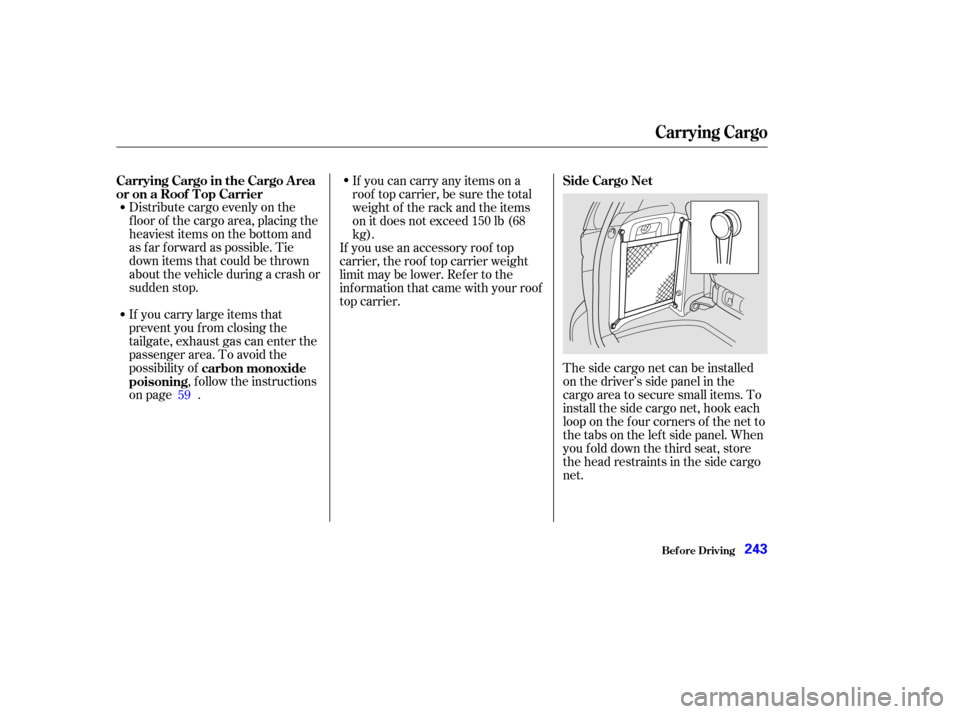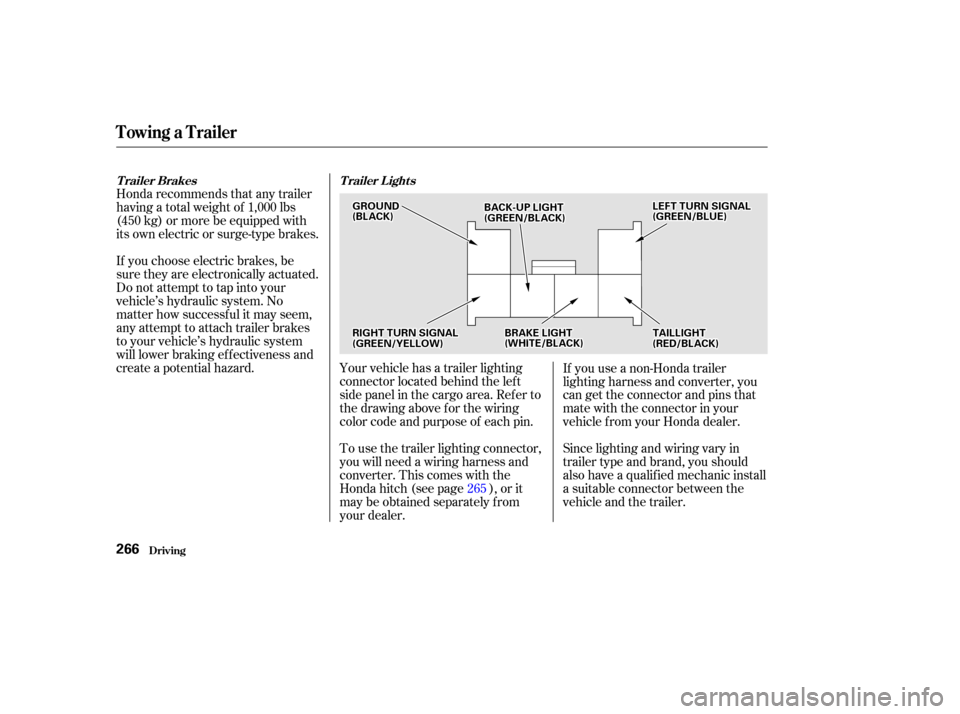Page 245 of 399

Store or secure all items that could
be thrown around and hurt
someone during a crash.
Be sure items placed on the f loor
behind the f ront seats cannot roll
under the seats and interf ere with
the driver’s ability to operate the
pedals, or with the proper
operation of the seats.
Keep the glove box closed while
driving. If the lid is open, a
passenger could injure their knees
during a crash or sudden stop.
This f igure includes the total weight
of all occupants, cargo, accessories,
and the tongue weight if you are
towing a trailer.
The f inal number is the total weight
of cargo you can carry.
If you are towing a trailer, add the
tongue weight to the number
above. Add up the weight of all occupants.
To f igure out how much cargo you
can carry: When you load luggage, the total
weight of the vehicle, all passengers,
cargo, and trailer tongue load must
not exceed the Gross Vehicle
Weight Rating (GVWR). The load
for the front and rear axles also must
not exceed the Gross Axle Weight
Rating (GAWR). The GVWR and
GAWRareprintedonthetire
information label attached to the
driver’s doorjamb (see page ).
Subtract the total f rom 1,267 lbs
(575 kg).
The maximum load f or your vehicle
is 1,267 lbs (575 kg).
370Carrying Items in the Passenger
Compartment
Load Limit
Carrying Cargo
Bef ore Driving242
Overloading or improper
loading can affect handling and
stability and cause a crash in
which you can be hurt or killed.
Follow all load limits and other
loading guidelines in this
manual.
Page 246 of 399

Distribute cargo evenly on the
f loor of the cargo area, placing the
heaviest items on the bottom and
as far forward as possible. Tie
down items that could be thrown
about the vehicle during a crash or
sudden stop.
If you carry large items that
prevent you f rom closing the
tailgate, exhaust gas can enter the
passenger area. To avoid the
possibility of, f ollow the instructions
on page . The side cargo net can be installed
on the driver’s side panel in the
cargo area to secure small items. To
install the side cargo net, hook each
loop on the f our corners of the net to
the tabs on the lef t side panel. When
youfolddownthethirdseat,store
the head restraints in the side cargo
net.
If you can carry any items on a
roof top carrier, be sure the total
weight of the rack and the items
on it does not exceed 150 lb (68
kg).
If you use an accessory roof top
carrier, the roof top carrier weight
limit may be lower. Ref er to the
inf ormation that came with your roof
top carrier.
59 carbon monoxide
poisoning Side Cargo Net
Carrying Cargo in the Cargo A rea
or on a Roof T op Carrier
Carrying Cargo
Bef ore Driving243
Page 265 of 399
Your Odyssey has been designed to
tow a trailer, as well as f or carrying
passengers and their cargo.
To saf ely tow a trailer, you must
observe the load limits, use the
proper equipment, and f ollow the
guidelines in this section.The
maximum weight you can tow
depends on several f actors. See
page f or limits f or your towing
situation. Towing a load that is too
heavy can seriously affect your
vehicle’s handling and
perf ormance. 263
Towing a Trailer
Driving
Load Limits
T otal T railer Weight:
262
Exceeding any load limit or
improperly loading your vehicle
and trailer can cause a crash in
which you can be seriously hurt
or killed.
Check the loading of your
vehicle and trailer carefully
beforestartingtodrive.
Page 266 of 399
�Î�Î�Î
�Î
�Î�Î
CONT INUED
To achieve a proper tongue load,
start by loading 60 percent of the
load toward the front of the trailer
and 40 percent toward the rear, then
re-adjust the load as needed.
The weight that
the tongue of a f ully-loaded trailer
puts on the hitch should be
approximately 10 percent of the
trailer weight. Too little tongue
load can make the trailer unstable
and cause it to sway. Too much
tongue load reduces f ront-tire
traction and steering control.
Including driver. Based on 150 lbs (70 kg) per occupant.
Weight limited to avoid exceeding rear GAWR (see page ).
Number of Occupants
2
3
4
5
6
7
Maximum Total Trailer Weight
Equipped with transmission coolerand power steering fluid cooler 3,500 lbs (1,580 kg)
3,350 lbs (1,520 kg)
3,200 lbs (1,450 kg)
3,050 lbs (1,380 kg)
2,900 lbs (1,310 kg)650 lbs (295 kg)
:
: 264
Towing a Trailer
Driving
Tongue Load:
263
Page 267 of 399

The best way to conf irm that vehicle
and trailer weights are within limits
is to have them checked at a public
scale.
Using a suitable scale or a special
tongue load gauge, check the tongue
load the f irst time you set up a
towing combination (a f ully-loaded
vehicle and trailer), then recheck the
tongue load whenever the conditions
change.
The maximum allowable weight of
the vehicle, all occupants, all cargo
and the tongue load is 5,665 lbs
(2,570 kg).
The maximum allowable weights
on the vehicle axles are 2,833 lbs
(1,285 kg) on the f ront axle, and
2,845 lbs (1,290 kg) on the rear
axle. The maximum allowable weight of
the f ully loaded vehicle and trailer
is 8,265 lbs (3,750 kg) with the
proper hitch and f luid coolers.
(See page f or inf ormation
about f luid coolers.)
265 Checking L oads
Gross Vehicle Weight Rating
(GVWR):
Gross Axle Weight Rating
(GA WR): Gross Combined Weight Rating
(GCWR):
Towing a Trailer
Driving264
Exceeding load limits or
improperly loading your vehicle
and trailer can cause a crash in
which you can be seriously
injured or killed.
Check the loading of your
vehicle and trailer carefully
beforestartingtodrive.
Page 268 of 399

Towing can require a variety of
equipment, depending on the size of
your trailer, how it will be used, and
how much load you are towing.
Discuss your needs with your trailer
sales or rental agency, and f ollow the
guidelines in the rest of this section.
Also make sure that all equipment is
properly installed and that it meets
f ederal, state, province, and local
regulations.Always use a saf ety chain. Make
sure that it is secured to both the
trailer and hitch, and that it crosses
under the tongue so it can catch the
trailer if it becomes unhitched.
Leave enough slack to allow the
trailer to turn corners easily, but do
not let the chain drag on the ground.
Any hitch used on your vehicle must
be properly bolted to the underbody,
using the six threaded holes
provided. A hitch and the required
f luid coolers designed especially f or
your Odyssey can be obtained f rom
your Honda dealer. If the total trailer weight is more
than 1,850 lbs (840 kg), you must
also use a weight distributing hitch.
This device transf ers weight f rom
the vehicle’s rear wheels to the f ront
wheels, and to the trailer’s wheels.
Caref ully f ollow the hitch maker’s
instructions f or proper installation
and adjustment.
If the total trailer weight exceeds
2,000 lbs (900 kg), you should install
a sway control device to minimize
swaying that can occur in crosswinds
and in normal and emergency
driving maneuvers. Your trailer
maker can tell you what kind of sway
control you need and how to install it.
You must also have a transmission
f luid cooler and a power steering
f luid cooler installed. These coolers
are available only f rom your Honda
dealer.
CONT INUED
T owing Equipment and
A ccessories
HitchesWeight Distributing Hitch
Saf ety Chain Sway Cont rol
T ransmission Fluid Cooler andPower St eering Fluid Cooler
Towing a Trailer
Driving265
Page 269 of 399

Honda recommends that any trailer
having a total weight of 1,000 lbs
(450 kg) or more be equipped with
its own electric or surge-type brakes.
If you choose electric brakes, be
sure they are electronically actuated.
Do not attempt to tap into your
vehicle’s hydraulic system. No
matter how successf ul it may seem,
any attempt to attach trailer brakes
to your vehicle’s hydraulic system
will lower braking ef f ectiveness and
create a potential hazard.Since lighting and wiring vary in
trailer type and brand, you should
also have a qualif ied mechanic install
a suitable connector between the
vehicle and the trailer.
Your vehicle has a trailer lighting
connector located behind the lef t
side panel in the cargo area. Ref er to
thedrawingaboveforthewiring
color code and purpose of each pin.
To use the trailer lighting connector,
you will need a wiring harness and
converter. This comes with the
Honda hitch (see page ), or it
may be obtained separately from
your dealer. If you use a non-Honda trailer
lighting harness and converter, you
can get the connector and pins that
mate with the connector in your
vehicle f rom your Honda dealer.
265
Trailer Brakes Trailer Lights
Towing a Trailer
Driving266
G GRROOU UNNDD
(
( B
BL LAA C
CKK)) B
BA
A C
CKK--U
UP P L
LIIGGH HT
T
(
( G
GR REEE
EN
N/ /B
BL LAA C
CKK)) L
LE
E F
FTT T
TU
UR RNN S
SIIGGN NAAL
L
(
( G
GR REEE
EN
N/ /B
BL LUUE E)
)
R
RI IGGH HT
T T
TU
UR RNN S
SIIGGN NAAL
L
(
( G
GR REEE
EN
N/ /Y
YE EL
LLLOOW W) ) T
T
A
A I
ILLL LIIGGH HT
T
(
( R
RE ED
D /
/B
BL LAA C
CKK))
B
BR
RAA K
KEE L
LIIGGH HT
T
(
( W
WH HI
ITT E
E/
/B
BL LAA C
CKK))
Page 270 of 399

Your vehicle tires and spare are
properly inf lated (see page ),
and the trailer tires and spare are
inflated as recommended by the
trailer maker.
When towing a trailer, you should
carry a f ull-size wheel and tire as a
spare in case you have a flat. If you
use the compact spare tire that came
with the vehicle, it may adversely
af f ect vehicle handling. See page
f or inf ormation on proper tire
size, and page f or inf ormation on
how to store a f ull-size tire. When
storing a f ull-size spare tire in the
trailer, f ollow the trailer maker’s
instructions.
Many states and Canadian provinces
require special outside mirrors when
towing a trailer. Even if they don’t,
you should install special mirrors if
you cannot clearly see behind you, or
if the trailer creates a blind spot.
Askyourtrailersalesorrental
agency if any other items are
recommended or required f or your
towing situation. When preparing to tow, and bef ore
driving away, be sure to check the
f ollowing:
The vehicle has been properly
serviced, and the tires, brakes,
suspension, and cooling system
are in good operating condition.
All weights and loads are within
limits (see pages and ).
Thehitch,safetychains,andany
other attachments are secure.
Allitemsonandinthetrailerare
properly secured and cannot shif t
while you drive.
The lights and brakes on your
vehicle and the trailer are working
properly. You may want to fill the fuel tank
with premium f uel. Premium f uel
provides improved perf ormance.
314
345
262 264 309
CONT INUED
Spare Vehicle T ire
Additional Trailer EquipmentPre-T ow Checklist
Towing a Trailer
Driving267